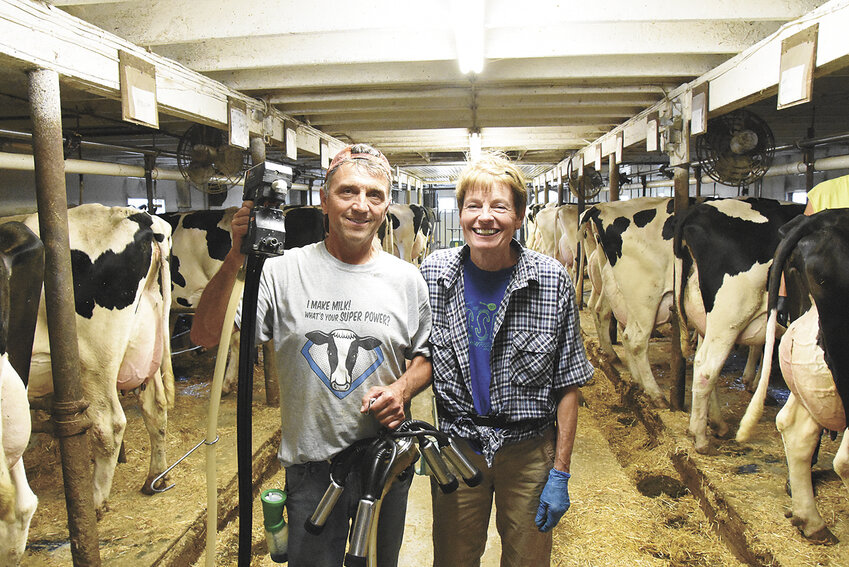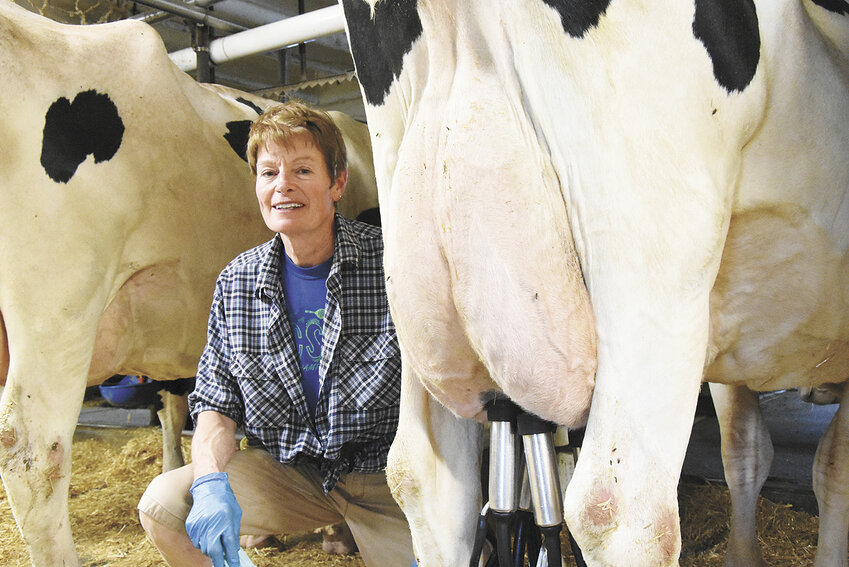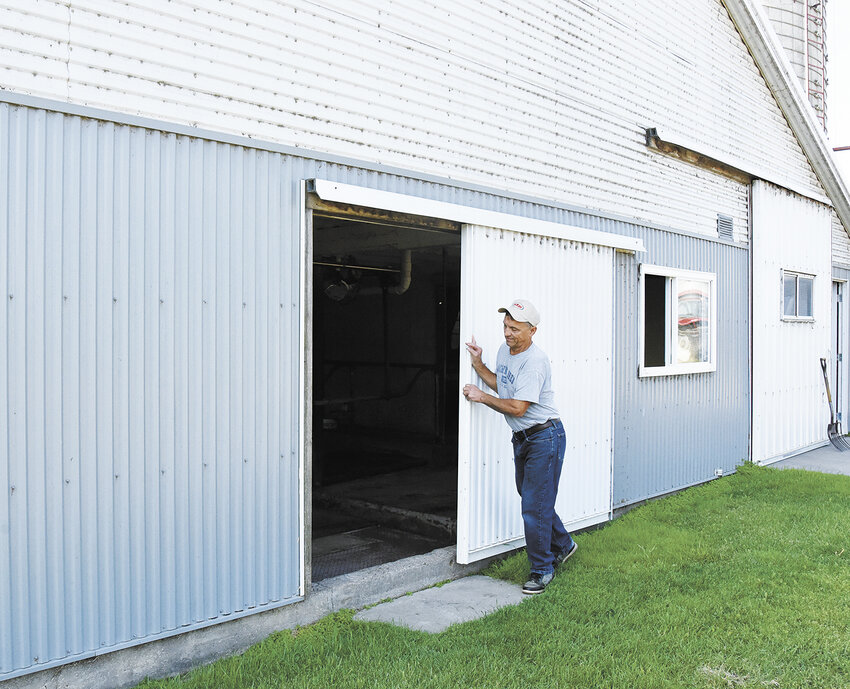 Jerry and Bev Pohlmann milk cows together Aug. 9 in their tiestall barn near Grey Eagle, Minnesota. The dairy herd left the farm Aug. 11 after the Pohlmanns decided to retire to allow more time to spend with their 14 grandchildren. (PHOTO BY MARK KLAPHAKE)
Jerry and Bev Pohlmann milk cows together Aug. 9 in their tiestall barn near Grey Eagle, Minnesota. The dairy herd left the farm Aug. 11 after the Pohlmanns decided to retire to allow more time to spend with their 14 grandchildren. (PHOTO BY MARK KLAPHAKE)
GREY EAGLE, Minn. — Jerry Pohlmann said it finally hit him when he closed the tiestall barn door after the last of his cows left the farm. He was truly retired from dairy farming.
“For the last couple years, I’d been telling myself that I’d milk one more year,” Jerry said. “I’ve had friends tell me, ‘You’ll know when the time is right.’ And, you know, the time was right.”
Jerry and his wife, Bev, have been milking 60 to 75 Holsteins in a tiestall barn since 1982 at their farm near Grey Eagle. They sold their cows Aug. 11.
“It’s been three weeks now, and it just feels good,” Jerry said. “We want to spend more time with our grandkids.”
The previous night, instead of milking cows, Jerry attended a high school varsity volleyball game in which three of his granddaughters were playing. Bev had spent the day at a college visit with another grandchild. With five children and 14 grandchildren, the couple will remain busy in different ways.
 Bev Pohlmann milks cows Aug. 9 on her family’s dairy farm near Grey Eagle, Minnesota. Bev and her husband Jerry milked cows together since 1982 and raised their five children on the farm. (PHOTO BY MARK KLAPHAKE)
Bev Pohlmann milks cows Aug. 9 on her family’s dairy farm near Grey Eagle, Minnesota. Bev and her husband Jerry milked cows together since 1982 and raised their five children on the farm. (PHOTO BY MARK KLAPHAKE)
“I’m not watching the clock anymore,” Bev said. “I can go somewhere and not have to think, ‘Ok, I’ve got to be back by 3:30 (p.m.).”
Jerry had planned to retire four years ago, when he was 60. Then he realized the barn would turn 50 years old in 2021. Cows would have been milked there for half a century. He decided to stick it out until then so that he could hold a celebration to mark the anniversary.
Six months before the party, his dad passed away, but his mother was there to cut a big red ribbon Jerry had tied across front of the barn.
“With 14 kids, 68 grandchildren and many great-grandchildren that Mom and Dad had at the time, it was a big party,” Jerry said. “The yard was full of cars with just family.”
However, Jerry did not retire.
“A lot of my friends retired at 62 and told me I was nuts (if I’d continue working after that),” Jerry said. “But when I got to 62, I thought, ‘I’m still feeling so good and my cows are smoking guns right now, so I’m going to keep going.”
In addition to milking cows and farm work, Bev began working at a school kitchen and loved it. When sale prices for cows became good, she said the timing seemed right. Jerry agreed. At 64, they sold the cows.
Looking back, both said dairy farming brought rewards to their lives, especially while raising a family. They taught their kids the importance of working hard and being responsible.
“Just the value of doing a good job — our kids have a good work ethic even now (in their current professions),” Bev said. “We had our meals with the kids. We got up extra early to milk in the morning so that I could get them something to eat and onto the bus.”
The family adjusted times for chores, even milking cows at 4 a.m., to allow the kids to participate in sports but also keep them involved in the aspects of the farm.
 Jerry Pohlmann shuts the door to the tiestall barn Aug. 30 on his farm near Grey Eagle, Minnesota. He and his wife Bev retired from dairy farming after milking cows together for 41 years. (PHOTO BY JAN LEFEBVRE)
Jerry Pohlmann shuts the door to the tiestall barn Aug. 30 on his farm near Grey Eagle, Minnesota. He and his wife Bev retired from dairy farming after milking cows together for 41 years. (PHOTO BY JAN LEFEBVRE)
“Even our grandchildren are going to have grown up having known the dairy farm because the youngest two are 8 years old,” Jerry said. “They were out here many times, many weekends.”
Still, letting go of dairy farming is hard. One of the Pohlmanns’ sons, Aaron, will continue running the farm as a crop farm. Jerry and Bev are considering raising youngstock with him. Aaron might remodel the tiestall barn into a machine shed, but not yet.
“I want the barn to stay empty for a year,” Jerry said. “We have plenty to do for the rest of this year anyway, so we will figure it out next year. It all started in 1971 when my parents built this barn.”
Jerry is the second generation on the farm. His parents purchased the farm in 1958.
“When Mom and Dad married, they got three cows from my dad’s sister and four cows from my mom’s dad,” Jerry said. “Then they bought a couple more. When they started milking, they had 15 cows.”
Jerry was 12 years old when they built the current tiestall barn with 48 stalls. Before that, his dad worked off the farm, and Jerry and his siblings milked cows with their mom. When the new barn was built, Jerry’s dad began dairy farming full time with the herd size increased to 40 cows.
“I milked cows before school and after school, but my parents let me play all the sports I wanted,” Jerry said. “I came from a family of 14 kids, so we had enough help.”
When Jerry started dating Bev, she lived 20 miles away in the town of Greenwald, but she spent time helping on her aunt and uncle’s farm.
Although Bev had not thought about becoming a dairy farmer, it fit into what she wanted in a career.
“I wanted to do something outside, an outdoor occupation,” Bev said.
When the couple married in 1982, she fit right into the dairy lifestyle.
“Bev and I milked side by side morning and night since we moved to the farm,” Jerry said.
Both said they enjoyed the feeling of accomplishing something through hard work.
“I liked to be busy all the time, and I liked taking care of calves,” Bev said. “I like to see them raised from a calf to a cow and to know that I did good work.”
The couple officially took over the farm in 1987. It was then that a three-year drought began, the height of it being in 1988.
“The technology of crops, the hybrids we have now, didn’t exist (in 1988),” Jerry said. “We’ve hardly had any rain this year, and the corn still looks good. If it were the drought year of 1988, 90% of the corn would probably be only knee high.”
In 1988, they received 0.2 inches of rain the morning of Mother’s Day.
“That was it from when the snow melted all the way to the first week of August,” Jerry said. “Then, we got 4 inches of rain and had one crop of hay, but it was a nice crop.”
He said it was probably the toughest year of farming he and Bev experienced.
“But, we were dug in,” Jerry said. “I thought, ‘I’m not giving up; I love dairy farming, so we are doing this thing.’ You go back to my parents’ or my grandparents’ tough times to what we considered our tough times — and Aaron will have something that is a tough time — but you just battle it out.”
Mostly, Jerry said, times have been good on the farm. They are also proud of improvements they were able to make to their herd.
“I took A.I. school and started breeding our own cows to top bulls,” Jerry said.
That led to a lot of change in 41 years. In 1982, their herd was at a 17,500 rolling herd average. In 2023, their herd was at 29,000.
“It was sad to see them go,” Jerry said. “They paved a lot of highway on this farm.”
He said the cows allowed them to buy land, remodel the house, put in tiling and buy farm equipment.
“When it was time (to retire), it was the right herd to sell,” Jerry said. “They were some awesome cows. The sale was good.”
With their herd gone, Jerry has found a way to maintain freedom with his schedule but still work with cows. His neighbor milks cows in a parlor and needed help. Jerry now milks for him — mornings only, on weekdays and some weekends, but at Jerry’s discretion.
“A lot of my family think I’m nuts, but I love it,” Jerry said.
Both Jerry and Bev said they feel busy but with more freedom. The tiestall barn stands pristinely clean and empty, but Jerry said he sees hope that young families on small farms will find ways to keep barns like his full, most likely by adapting them with technology.
“The one good thing about robots is, if you want to stay small, you can have one robot and milk your 60 cows, which is nice for a small family, or you can get two robots and milk what might be more financially (viable), such as 100 to 120 cows,” Jerry said. “That’s going to save a lot of these dairy farms.”
Comments
No comments on this item Please log in to comment by clicking here